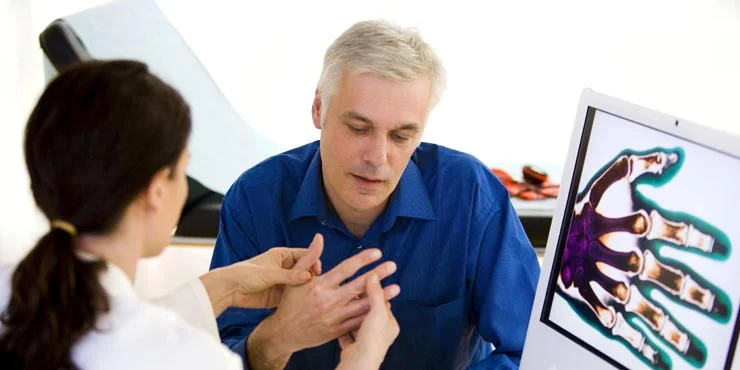This is how our application simplifies the booking and administration process. Interested >>
Rheumatology
Rheumatology is a medical specialty that deals with the diagnostic and conservative treatment of musculoskeletal diseases. This branch of science deals with the abnormalities of the musculoskeletal system and provides professionally adequate treatment and care for peripheral joint diseases, degenerative and inflammatory spine diseases, and metabolic diseases /osteoporosis/.
A rheumatologist specialist examines and treats those symptoms and diseases which develop in the bones, joints, muscles, tendons, tendon sheaths, bursae, spine, and certain peripheral nerves, but do not require a surgical intervention yet.

Most common symptoms:
- Pain,
- timeline (acute, subacute, chronic)
- origin (mechanic, inflammatory)
- limited mobility,
- other: numbness, joint cracking, joint swelling, local tenderness to pressure.
Which symptoms indicate that you should see a rheumatologist?
Symptoms affecting one or two body regions:
- cervical pain and/or arm pain, numbness,
- shoulder pain, elbow pain, swelling
- joint pain or swelling of the wrists and the hands, finger numbness,
- back pain, low back pain, sciatic pain and/or lower limb pain, numbness,
- hip pain, knee pain, swelling, joint cracking,
- ankle and foot pain, swelling and deformities, foot and toe numbness,
- limited range of movement in any of the joints,
- limping,
- muscle weakness in the lower or the upper limb,
- heel pain
Symptoms affecting multiple body regions:
- pain in multiple joints,
- inflammation in multiple joints (its treatment is connected to assigned arthritis centers),
- diffuse muscle pain,
- and related general symptoms e.g., weakness, temperature, fever, and skin symptoms
How is a rheumatological examination performed?
- The first step is to obtain an accurate medical history of previous surgeries, diseases, current symptoms, and regularly taken medication.
- During physical examination, the patient is partially uncovered (wearing underwear only) while their walk and posture are observed, region-specific targeted tests are performed depending on the symptoms including pain-provoking tests, the range of motion is recorded and the fundamental neurological examinations (muscle strength, reflexes, sensation, pathological reflexes) are performed too.
- The patient’s previous or current discharge summaries, findings (laboratory tests, X ray, CT, MRI, isotope scans, neurophysiology, ODM, etc.) – if there is any – are reviewed and assessed.
- The definite or suspected diagnosis is recorded.
- A diagnosis will be made, and if there was not any yet, the diagnostic modalities will be listed (laboratory tests, X ray, CT, MRI, isotope scans, neurophysiology, ODM, etc.)
- A recommendation for a treatment plan will be provided.
Which tests will support making the accurate diagnosis other than a physical examination?
- Laboratory tests
- Imaging studies: ultrasound, X-ray, CT, MRI, complete bone scintigraphy scans
- Neurophysiology
- Bone densitometry (DEXA)
- Diagnostic nerve blocking injection in spinal disorders
Whis treatment methods will be recommended?
- Physical therapy which includes various types of physiotherapy, massage therapy, ultrasound treatment depending on the local equipment, shockwave therapy, iontophoresis, selective nerve stimulation, laser therapy, magnetotherapy, kinesiology tape.
- Anti-inflammatory medicinal treatment for pain relief.
- Setting and continuing an anti-osteoporosis therapy depending on the professional skills.
- Administration of an anti-inflammatory injections for pain relief into the joints or locally.
- Recommendation for infusion treatment.
- Recommendation for topical treatments (cremes, patches, packs, sprays for pain-relief and inflammation reduction).
- Administration of injections containing hyaluronic acid / or collagen for cartilage protection, administration of steroid injections.
- Recommendation for using medical aids.
- Platelet rich plasma therapy (infiltration of the patient’s own blood) depending on the professional background and skills.
Which are the most common rheumatological problems?
Rheumatology deals with the wide range of musculoskeletal problems. The most common symptoms are spine pain (pain in the neck, back, hips, shoulders, wrists and hands, knees, foot or heels).
The rheumatological diseases which are responsible for these symptoms can be divided into three large groups:
1. Diseases of wear and tear (degenerative diseases)
- Joint wear, cartilage wear (arthrosis)
- Wear and tear of the intervertebral discs (discopathy)
- Calcification of the vertebrae (spondylosis)
- Intervertebral disc herniating (spinal herniation)
- Osteoporosis, compression fractures of the vertebrae
2. Inflammatory joint diseases
- Joint inflammation (arthritis)
- Tendon inflammation (tendinitis) not requiring surgery
- Nerve inflammation (neuritis)
- Compression syndromes (carpal tunnel syndrome, elbow tunnel syndrome which does not require surgery, piriformis syndrome)
- Gout
- Tennis elbow, golfer’s elbow
- Treatment of polyarthritis, the ankylosing spondylitis disease group, systemic inflammatory diseases accompanied by autoimmune diseases, setting and monitoring a potential biological therapy is limited to the assigned arthritis centers.
3. Metabolic diseases
- Osteoporosis
If the patient shows symptoms suggestive of COVID infection, a rapid antigen test may be requested at the discretion of the physician.
Feel free to contact our specialists!
At the Buda Health Center, you have the opportunity to attend the private practices of more than 300 renowned specialists, offering expertise in nearly 45 medical specialisms, at five locations. Personalized care is provided by a well-trained and empathetic staff of professionals, who have been working together for a long time. Based on our 24 years of experience and the feedback received from our 450,000 clients, we are constantly working to organize our healthcare services in the most efficient way possible for those who visit us, paying respect to their needs and time.






